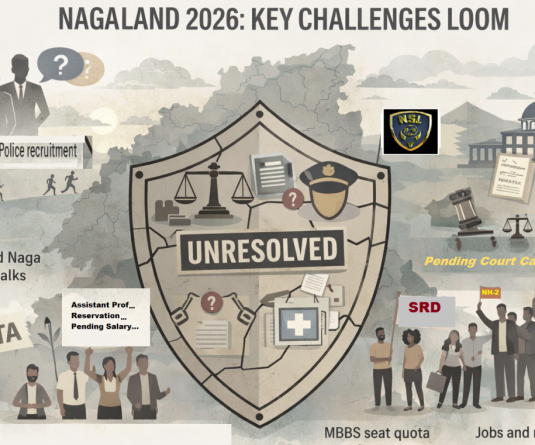On way for a game or two, a local hunter pauses to read a notice board prohibiting hunting, in Mokochung.
Limalenden Longkumer
Mokokchung | December 1
Hunting to many a Naga is a favourite leisure activity. Almost every Naga family owns a 12 bore shot-gun or a .22 rifle or at least an air rifle, if not a rubber catapult. ‘Hunting season’ normally begins by October end and goes on till the month of March. During this time of the year, hunters with their guns slung across their shoulders out into the jungle are a common sight. They may or may not be aware of the importance of preservation of wildlife, but except for an ‘unlucky few’, most hunters return home with a kill.
Nonetheless, giving a sigh of relief (at least to nature lovers), there seems to be a growing interest among the people in preservation of wildlife, in Mokokchung. According to Bendangkokba, the Deputy Commissioner of Mokokchung, the sense among the common people over preserving wildlife is “best in Mokokchung” and cited several villages in the district that had demarcated areas within their respective jurisdictions as reserved forests. These “community reserve forests”, according to the deputy commissioner, is largely due to the initiatives taken by village councils.
According to him, hunting in Mokokchung has to a certain extent been “put under control”. Bendangkokba, however expressed concern that the rivers in Mokokchung are “hazardously clean”, because the locals use chemicals in the rivers to fish.
The deputy commissioner cited the villages of Mopungchuket, Longmisa, Changtongya, Chuchuyimlang, Yaongyimsen and Longkhum villages who all have “community reserve forests.” He also said that unlike last year, hunting migratory birds was largely controlled this year after the district administration imposed a ban on killing the birds. In Longmisa village, according to the DC, villagers are preserving several antlered stags along the Dikhu river catchments area. The Mopungchuket village council, according to the DC, has also reserved a ‘large forest area’ for preservation of wildlife. Both villages are reported to have banned hunting or fishing in these reserved forests and have also informed neighboring villages about the same. There are no wildlife sanctuaries or reserved forests under the government, in Mokokchung district.
Although some villages are making efforts to preserve wildlife, it is observed that much remains to be done in this aspect. One glaring example of depleting forest land in the district is the Minkong forest. Minkong, which about a decade ago was the botanical hotbed in the district, today stands barely covered by anything. The forest has depleted so much so in the past decade that it can no longer provide habitat for wildlife today.
Minkong forest area comprises of lands belonging to three villages, namely Chuchuyimpang, Longmisa and Sungratsu. The National Highway 61 cutting through the heart of the forest and the adjacent establishment of the CRPF and DEF camps can be considered a contributing factor to the fast depletion of the forest. With the consorted effort of the three villages, however, what little that is left of the forest somehow can be preserved.






